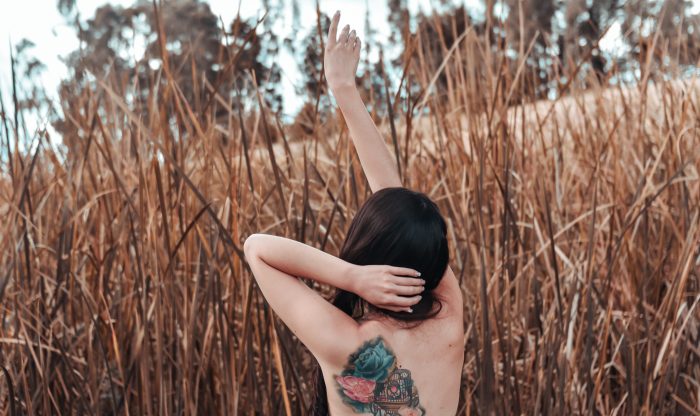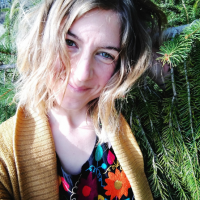The revelation began to seep in right around the time I got my first tattoo.
I worked in customer service at the time, the freshly-inked design colored my whole forearm, and people naturally wanted to see it.
The artwork shows a great blue heron flying against a backdrop of aquamarine sky and birch forest. There is also an old wooden door set into the trees like the entrance to a secret garden. Below everything, the typeset words read: We belong to each other.
I spent over a year designing and deciding upon this artwork; each piece contains a story that could fill chapters. I felt proud to have it on my person, but sharing it felt vulnerable in an unexpected way.
It was as if I was flashing people with my naked soul each time the ink was exposed.
The most common reaction I got was, “Aw, does your husband have one too?”
I was flummoxed.
At first, I tried to crack jokes in response: “My husband and I aren’t really the types to get matching tattoos.” And this was true, we certainly aren’t.
We also aren’t the types of people to use possessive language to describe our love.
I’ve experienced too much loss, in all kinds of relationships, to conceive of permanently marking myself for someone else. If I ever want to memorialize someone, fine, but I don’t need a record of my marriage on my skin.
Yet, in sound-bite conversations, how could I possibly explain to people that this art, these words, had absolutely nothing to do with my husband? Most people wouldn’t get it, even if I wrote a book about it.
So, here I am, writing an article instead.
I’ve been married close to eight years, but it took me about six years of wrestling the grief of what our marriage wasn’t to come to terms with something beautiful. It is something shocking, and maybe even scandalous:
My relationship with my husband isn’t my life’s greatest love.
The handful of people who truly know me, know I adore him. They know I would go to great lengths to demonstrate my love for him (save getting a tattoo of us). Our relationship is unique, and when I say that, I don’t mean in the universal way that every relationship is unique. I mean that I have literally never met, or read of, anyone with a story like ours. The things we have endured together; the things that are our “normal” would end many marriages. These are stories I may never publish because, unlike tattooed skin, they feel too vulnerable for permanent ink on a page.
In a world that preaches with increasing fervor, “If you’re not getting your needs met in a relationship, girl, cut your losses and move on,” every passing year that we remain married is its own miracle. That story itself is enough for me.
And yet, the way things are between us—the way lack has carved its space in me—is the reason I found my way to the love that now resides on my skin in full color.
I’ve come to see that the love affair I’ve always wanted is not with a human, but with the living, breathing, natural world outside my door.
This love, to be clear, is not a love that replaces, rivals, or demotes the love between my husband and I. It exists as something bigger, something eternal, something that will always be, no matter the impermanence of us human beings and the relationships we form—even for a lifetime.
In the great loneliness and grief that swept in after marriage, I fell in love with birds. Many afternoons I’d escape down to the lake and watch them in flight, skimming the water, diving beneath, bobbing along in synchronized formation.
It was the herons that captured my heart. Those stately, gangly, relics of the dinosaur age, hunched in the bushes, or on logs near lake shores with their plumage tossing in the wind. Almost always alone, yet knowing when and how to come together. Almost always existing in silence, except for the occasional otherworldly cry piercing the air; fierce, and graceful, and exceedingly patient.
They were mirrors to my life, my soul, and my transforming identity.
Loving the herons led to me loving the water, and the land that housed and fed them; to hours spent lugging bags and buckets of trash, picked up from lakeside habitat.
Loving the lake led to me loving the rain and the snow piling on the mountain—because when the drought came in and stripped her to her skeleton, I, too, felt the agony in my flesh.
Loving them all led to the rage and grief over what we’ve done to them. The rage and grief led me to become an activist and protector, to write and create beauty from the sorrow.
Shortly after my first tattoo session, my husband showed me a video clip of a fresh atrocity in Mexico, where he was born. A group of rich entrepreneurs decided to overtake a wetland habitat in Cancun and bulldoze it in the middle of the night. They did it to build more resorts. In the process, they destroyed 90 percent of the wildlife population in the wetland.
They killed them, while they were sleeping.
In the video, a young Mexican man talked passionately while gently cupping a dead bird in one hand. It was buried in the dirt for two days, he said, before they uncovered it. The little bird was the color of the sun and the sky, and one wing was nearly torn from its lifeless body. He peeled back the wing to show the gaping wound. I stared at it and my stomach clenched in pain, on the verge of retching.
I left the room to sit alone in the dark, cradling my newly tattooed arm in my hands while the tears came in waves. I was acutely aware, since getting myself inked, that these violations against the natural world felt more personal. They were violations against me now. Maybe because I cared enough to have my own flesh engraved as an identification with this nonhuman world that had already tattooed itself on my insides. This tattoo was more than beautiful artwork, it expressed one of my most deeply embodied beliefs.
We belong to each other.
I remember how intense the pain was at certain points while the artist worked on my arm. Instead of trying to escape the pain, which I couldn’t do, I went into it. I imagined myself as a tree being carved. It didn’t take the edge off the pain, but it did channel it. I wondered to myself what a tree feels when its bark is etched with a knife. Is it anything like piercing through a layer of skin with a set of needles?
As I wondered this, trees slowly emerged on my arm, colored in drops of my blood.
To etch this artwork forever on my flesh was and is a physical reminder that we are all made of the same stuff. It was and is my vow to the world, and all the more-than-humans who are my family, that I will love them as I would myself.
This tattoo was one of my deliberate responses to the rage that boiled up in me and still does.
Harness this, translate it into art, it says. Plant life where you can in all this death.
The world is a festering wound of rage, filled with the voices of suffering, injustice, grief, violation, and despair. I could add yet another angry voice to this, and it would quickly be consumed in the noise.
Or, I could find another way. So I did.
I continue to, as an activist, a writer, an artist, and a mother.
Here’s the morbid, human truth: we mere mortals lose loved ones every day; even the ones tattooed on our skin, and in our hearts. The ones we vowed “till death do us part,” and the ones we vowed we could never live without, in the blink of an eye, can be taken from us.
We may carry their love with us always, but there is the tangible tearing of separation, the grief of losing the physical presence of the ones we loved forever. Perhaps, in time, new loves and lovers come to us. Perhaps the one we lost was our definitive “one great love.”
But with this love I have for the earth, nothing short of my own death will ever tear her fully from me, no other lover will diminish her. Other loves may come or pass away, but this love will remain as the cornerstone of my days.
Even as she, too, is passing away.
For this is also the truth, these words I found penned in a journal from two years ago:
“The land has been my lover. I breathe it, inhabit it, seek to memorize it, as we do the ones we love. All these pictures, these treasures I collect, these words, are they not the attempts of a lover to deny impermanence? I am afraid, deep in my soul, that all of this is slipping away and I am desperate to hold it all. To remember these faces. I don’t know who I am without them.”
No matter how much I love my husband, I know who I am without him. But I don’t know who I am, or how I can continue to be without this earth.
I am of her. I am of all the trees and plants, birds and animals, water and air, dirt and rocks that exist together in this place.
At the end of the day or the end of life, the most stunning love stories are those which have been wholly embodied. And mark my words, this one will be.








Read 19 comments and reply